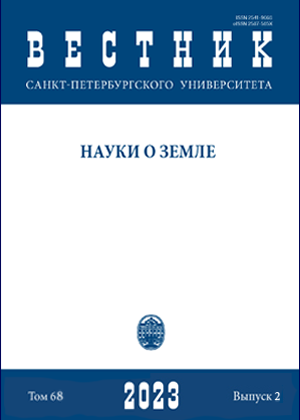Geochemistry of Holocene–Late Pleistocene sediments in the Berezovka River valley (Near-Yenisey Siberia)
DOI:
https://doi.org/10.21638/spbu07.2023.206Abstract
Despite their great importance, Holocene–Late Pleistocene sediments are poorly studied in the valleys of rivers in the Krasnoyarsk forest-steppe territory. We present the first detailed study of the geochemical composition of the first floodplain terrace sediments in the valley of the Berezovka River, and the continuous accumulation that occurred at the Late Pleistocene-Holocene (from 20833 ± 519 cal yr BP). This is of great fundamental importance and is the basis for further studies on the influence of anthropogenic activities on the natural environment in the Krasnoyarsk agglomeration. The sediments were covered by modern alluvial dark-humus hydrometamorphosed soil. Macromorphological studies and investigation of the humus content have revealed a well-developed process of humus formation and humus accumulation, a gley process. The measured contents of some elements (U, Pr, Rb, V, Bi, Cd, As, Th, Ga, Co, and Sm) exceeded the respective Clarke values for the Earth’s crust. The distribution of most elements and their accumulation in the Middle-Late Holocene (from to 5477–4985 to 1241–803 cal yr BP) in the middle of the sediment profile is explained by the high content of mud and clay minerals. Based on the coefficients of radial migration, we established that most of the studied elements were introduced into the sediments during high water levels and floods. The values of palaeomarkers indicate a change in climatic conditions in the Late Pleistocene and Holocene from dry and cold to more humid and warm, and from arid and cold (in the Early Holocene) to modern climatic conditions, respectively.
Keywords:
Geochemistry of sediments, radiocarbon dating, Holocene, Late Pleistocene, Berezovka river first floodplain terrace, alluvial soils, Krasnoyarsk forest-steppe, Yenisey River basin
Downloads
References
Downloads
Published
How to Cite
Issue
Section
License
Articles of "Vestnik of Saint Petersburg University. Earth Sciences" are open access distributed under the terms of the License Agreement with Saint Petersburg State University, which permits to the authors unrestricted distribution and self-archiving free of charge.






